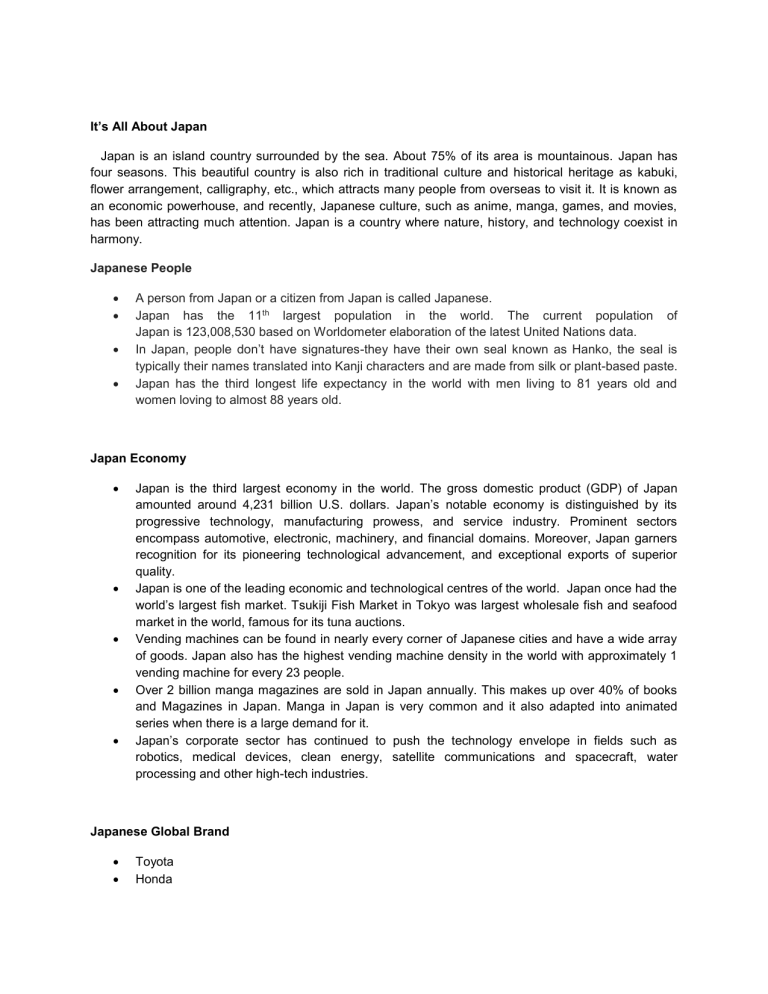
It’s All About Japan Japan is an island country surrounded by the sea. About 75% of its area is mountainous. Japan has four seasons. This beautiful country is also rich in traditional culture and historical heritage as kabuki, flower arrangement, calligraphy, etc., which attracts many people from overseas to visit it. It is known as an economic powerhouse, and recently, Japanese culture, such as anime, manga, games, and movies, has been attracting much attention. Japan is a country where nature, history, and technology coexist in harmony. Japanese People A person from Japan or a citizen from Japan is called Japanese. Japan has the 11th largest population in the world. The current population of Japan is 123,008,530 based on Worldometer elaboration of the latest United Nations data. In Japan, people don’t have signatures-they have their own seal known as Hanko, the seal is typically their names translated into Kanji characters and are made from silk or plant-based paste. Japan has the third longest life expectancy in the world with men living to 81 years old and women loving to almost 88 years old. Japan Economy Japan is the third largest economy in the world. The gross domestic product (GDP) of Japan amounted around 4,231 billion U.S. dollars. Japan’s notable economy is distinguished by its progressive technology, manufacturing prowess, and service industry. Prominent sectors encompass automotive, electronic, machinery, and financial domains. Moreover, Japan garners recognition for its pioneering technological advancement, and exceptional exports of superior quality. Japan is one of the leading economic and technological centres of the world. Japan once had the world’s largest fish market. Tsukiji Fish Market in Tokyo was largest wholesale fish and seafood market in the world, famous for its tuna auctions. Vending machines can be found in nearly every corner of Japanese cities and have a wide array of goods. Japan also has the highest vending machine density in the world with approximately 1 vending machine for every 23 people. Over 2 billion manga magazines are sold in Japan annually. This makes up over 40% of books and Magazines in Japan. Manga in Japan is very common and it also adapted into animated series when there is a large demand for it. Japan’s corporate sector has continued to push the technology envelope in fields such as robotics, medical devices, clean energy, satellite communications and spacecraft, water processing and other high-tech industries. Japanese Global Brand Toyota Honda Nissan Panasonic Sony Canon Japan Inventions 1. Electric Rice Cooker – The first electric rice cooker (suihanki) were produced by Mitsubishi Electric Corporation in 1955. 2. Blue LED – In 2014, Shuji Nakamura, along with two scientists, Isamu Akasaki and Hiroshi Amano, won the Nobel Prize in physics for the invention of blue light-emitting diodes (LEDs). It was made in 1990s. 3. The Novel – The Tale of Genji, written in the 11th century is considered the first novel ever written. It was written by a woman named Murasaki Shikibu. 4. Emoji – Emoji was created by Shigetaka Kurita and his team at the company NTT DoCoMo, he grew frustrated with using only text as a way to communicate information. They developed images to represent emotions as a solution. 5. QR Code – It was invented in 1994 by a Toyota subsidiary called Denso Wave to help with the manufacturing process. Japan Sport Sumo wrestling is the national sport of Japan. Sumo is a type of competitive full-contact wrestling in which a rikishi (wrestler) tries to drive his opponent out of a circular ring (dohy). Karate is the most popular form of martial arts to come from Japan. It began in Okinawa as common fighting used by the Pechin class. Over time, this form of fighting was used by the higher classes to study various styles of discipline. Karate can also be practiced for self-defense or combat sports. Japan’s National Attire The kimono is a traditional Japanese garment and Japan’s national attire. The kimono is a wrapped-front garment with square sleeves and rectangular body that is worn left side and folded over the right. The kimono is typically worn with a broad sash called an obi and is frequently paired with zori sandals and tabi socks. Japan Tourist Spots 1. Mount Fuji, located in Japan, is an iconic symbol of the country. Standing at 3,776 meters, it offers breathtaking views and attracts thousands of visitors each year, both climbers and sightseers alike. 2. Osaka Castle is one of the most visited attractions in Japan. It was built by a famous Japanese warrior Toyotami Hideyoshi in 1586. 3. Golden Pavilion is one of Japan’s most popular tourist is situated in Kyoto. It is highly regarded for its stunning architecture. The temple is backed by lush forest and fronted by a beautiful garden and lake. 4. Tokyo Imperial Palace is the primary residence of the emperor of Japan. Dating back to 1457, the palace is surrounded by a beautiful gardens and it is very popular tourist attraction. 5. Himeji Castle is yet another UNESCO World Heritage site, known as the ‘White Heron Castle’ because of its white exterior and the way it resembles a bird taking flight. The castle is surrounded by a beautiful park with cherry blossom trees and a moat. It is also has numerous defensive features, including walls, gates, and towers.




